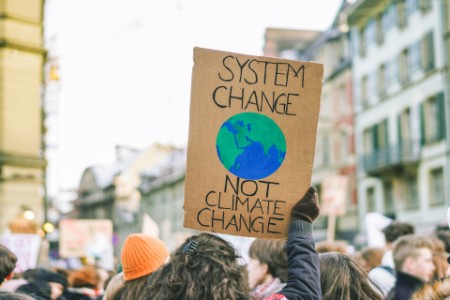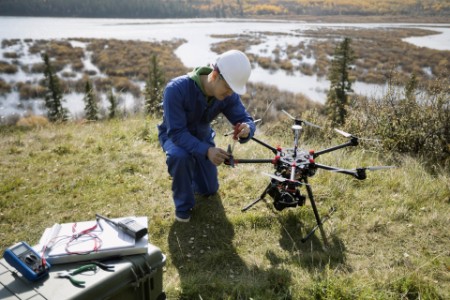
Chapter 1
The topics of digitalization and decarbonization belong together
The ecological shaping of transformation can only be achieved through digitalization
Alongside climate change, globalization and demographic change, digitalization is one of the developments that are shaping our world. Digitalization in itself is neither good nor bad for achieving climate targets. It depends on what we make of it – whether we let it roll over us or put it to good use. New information processes can promote transparency, for example about the ecological footprint of products. However, this change will only take place to its full extent when the technologies are integrated into society as a matter of course: into organizational procedures, work processes, human behavior, business models, and political action.
Decarbonization and digitalization are megatrends that will force sectors and industries to undergo structural change and fundamentally alter traditional business models. Swiss companies can gain advantages in digital competition if they see digitalization as a driver of sustainability. They now have the choice between a restructuring and adjustment of the business model or a potential loss of the basis for the business. New business models are needed that place sustainability at the heart of business activities: it is no longer a question of having an economic strategy that works from a sustainability perspective, but rather a sustainability strategy that works from an economic perspective. The transformation to a lower-carbon business model must therefore become an important cornerstone in the strategy of every company. To implement such a change of direction, in addition to cross-industry cooperation between companies, it requires a climate strategy, measurable goals, clearly defined action plans, and reporting that assesses the effectiveness of the measures.

Chapter 2
Digital technologies as an opportunity for environmental policy
The window of opportunity in which digital technologies can act as drivers of sustainability is now open
Digitalization can develop its full ecological potential above all where it fundamentally changes the present: lifestyles and consumption styles, economic activity or the organization of energy systems, cities, and transport, for example. Digitalization is not a collection of individual technologies. The actual effect stems from the ever-changing interaction of different technologies – in other words, when different hardware components are networked with each other and controlled by intelligent software. Digitalization is developing rapidly and with it the demand for energy and valuable resources. The increased power demand and resource consumption are due, among other things, to the rapidly growing data traffic. Between 2017 and 2022 alone, global data traffic is expected to triple to around 400 billion gigabytes per month – equivalent to the storage space of 100 billion DVDs. The power for the brave new world of smartphones, streaming services, and social networks has so far mainly come from fossil fuels. In just a few years – in some estimates – the digital industry will cause more carbon emissions worldwide than all motorized traffic.
Digitalization already accounts for
4%of global greenhouse gas emissions.
This is about as much as the combined emissions share of Canada and Germany.
One might think that digitalization will become a climate killer, but that doesn't have to be the case. Because at the same time, digital solutions can promote climate protection, clean air, intact soil, and the preservation of biodiversity. Artificial intelligence helps to process more plastic waste into plastic for production. Smart textiles turn disposable items into durable and recyclable fashion. Digital solutions for the home office such as video conferencing systems create accepted alternatives to business travel in the shortest possible time. These are just three of countless examples of digital creativity.
Digital solutions are not an end in themselves. The environmental policy of digitalization focuses on the whole. The areas of application in which digital technologies can be used in the interests of sustainability are extremely diverse:

Chapter 3
Efficiency strikes back – the rebound effects of digitalization
Guard rails are needed to ensure that digitalization does not become an accelerator of ecological destruction
In general, it is often observed that savings through increased energy efficiency in new technologies tend to result in a "rebound effect." The rebound effect describes the phenomenon that only a part of the planned savings from new technologies materialize, or none at all, as it leads to increased consumption. How big the impact of digitalization on our climate goals will be depends strongly on how it is managed. First and foremost, digitalization, especially giant data centers or blockchain technologies, leads to increased electricity demand. In addition, numerous smart home applications in private households are also increasing demand. The German Federal Environment Agency (UBA) estimates that rebound effects cancel out on average about 10% to 30% of the potential savings from energy-efficient technologies. This is because companies and consumers often invest the resources released into additional production and consumption. Therefore, digitized sustainability efforts are primarily based on the energy system transition, which covers the demand for electricity through sustainable production such as wind, hydropower, and photovoltaics. In addition, energy suppliers can help by transparently communicating power consumption to the end consumer. To tap into the positive effects of digitalization, it is therefore essential to address our digital hunger for energy in a sustainable manner. Only in this way can digitalization be seen as an opportunity and part of the solution for achieving our climate neutrality goals.

Chapter 4
Switzerland as a pioneer in the climate debate
Three fields of digital transformation
Last month, the "Digital Switzerland" strategy was updated, placing a sharper focus on achieving environmental protection goals through digitalization throughout Switzerland and incorporating the effects of the corona crisis. The strategy identifies nine fields of action which, among other things, should help to "reduce the ecological footprint and energy consumption (of Switzerland)" – one of the five core objectives of the strategy.
1. The energy system transition – the basis for sustainable digitalization
You soon realize why energy is at the heart of green digitalization. For example, the switch to video conferencing only exploits the full savings potential if the technologies used are also powered by renewable energies. This is not the only reason why the energy sector is under pressure to adapt. The energy consumption of private households, industry, and transport is responsible for over 75% of Switzerland's greenhouse gas emissions. Since 1990, however, greenhouse gas emissions per unit of final energy consumption have fallen sharply because of the increased use of non-fossil energy sources and the substitution of oil with natural gas. Decoupling digitalization and emissions therefore still remains the goal.
Digitalization is the underlying enabling factor of the energy system transition, as it allows us to navigate the complexity of the decentralized, renewable energy supply system. Digital innovations can help drive the energy system transition. In addition to the goal of ensuring a stable power supply, renewable energies must be expanded and climate-damaging emissions reduced. However, the expansion of the power grids is far from sufficient in this respect, so that decentralized, demand-oriented control is increasingly required. AI could support the decentralization of grids and control mechanisms by analyzing the necessary information about power supply and demand in real time and processing it by means of autonomous decision systems. It also enables optimized grid planning, the result of the intelligent interplay of energy production and energy consumption. Buildings will be equipped with smart metering systems that allow the best possible regulation of peak load and off-peak periods. In the future, for example, the surplus energy from non-controllable energy sources such as wind power could be stored at night in the batteries of empty electric cars attached to the grid, and called up as needed. The "Smart Grid Ready" label was developed to certify houses and properties that enable such smart communication with the grid. Through "open innovation," Switzerland is focusing primarily on the development of digital applications and solutions which make it possible to manage the existing complexity of the renewable energy network and its targeted use in a simplified manner.
2. Potential of digital solutions for environmentally friendly transport
According to various studies, the fields of action of "infrastructure" and "environmental protection, natural resources, and energy" show the greatest GHG savings potential through digitalization. The mobility sector in particular offers a significant opportunity to reduce greenhouse gas emissions. In 2018, road traffic was responsible for 32% of total greenhouse gas emissions and 40% of carbon emissions in Switzerland, making it the largest single offender. Almost two thirds of these emissions were attributed to passenger traffic. Not surprisingly, flexible solutions such as mobile working or video conferencing instead of business trips are therefore considered to have the greatest savings potential. The hypothesis is: It is more energy-saving to "transport bits instead of atoms." For example, Prof. Lorenz Hilty estimates that using video conferencing instead of air travel quickly reduces energy requirements by a factor of 100 (international air travel is responsible for approximately 11% of all Swiss GHG emissions).
In order to realize the full potential for savings in mobility, efforts are being made throughout Switzerland to create an efficient overall transport system. "Smart Mobility" puts modern technologies in the foreground: Sensor technology, AI-based capacity utilization control in public transport, and real-time data evaluation are to be used to control the traffic flow in the best possible way, to save resources, and to use existing infrastructure optimally (e.g., traffic light control by detecting approaching cars). With the help of the capacity information generated, passengers can be offered alternative routes. The use of such technologies could be particularly helpful in the corona crisis. If fewer passengers are on the road during rush hours, the risk of infection is reduced. In addition to appropriate apps for access, investments in real-time data that provide information on the utilization of individual buses and trains are therefore required.
3. Making digital infrastructure and data centers more ecological
In order to manage the high complexity of the use of innovative technologies for the environment, as described above, improved data collection and interdisciplinary cooperation are required above all. One major weakness of current efforts in Switzerland is that they are often carried out at cantonal or local level and the data collections harvested are not interoperable. However, the interoperability of data collections is the key to developing cross-cantonal solutions and nationwide SMART infrastructures, pooling resources, and avoiding redundant capacities. The "once only" principle will be applied, whereby in future data will be collected only once and made accessible to all participants through open data infrastructures.
One further challenge to sustainability in this respect is the necessary scale of data collection and real-time data acquisition, for whose timely and relevant analysis ever larger data centers are required. Data centers are responsible for 20% of the worldwide energy consumption of digitalization. In Switzerland, their share in total emissions from the information and communications technology sector increased from 33% to 45% between 2010 and 2020. Green energy is therefore central to reducing greenhouse gas emissions, as manufacturing emissions play a comparatively small role in such centers. In comparison, the emissions generated during the manufacturing process of consumer technologies are much more significant, accounting for 75% of total life cycle emissions. Data centers are a major driver of the increase in greenhouse gas emissions. To address the challenge posed by data centers, the Swiss Datacenter Efficiency Association (SDEA) was developed on the initiative of HPE and digitalswitzerland. In future, their task will be to award the "Swiss Data Center Efficiency Label" to particularly energy-efficient data centers in order to create an incentive for innovative and sustainable solutions in this area as well.
Summary
Digitalization can provide a much better, more transparent picture of the state of the world, nature, and the environment. However, the application of new technologies does not automatically result in a positive effect on the environmental balance. That's why we need to design digitalization in such a way that it can contribute to achieving our climate-neutral goals. At the same time, we must reduce the consumption of energy and resources from fossil fuels in order to achieve environmentally compatible digitalization. The corona crisis is acting as an accelerator of digitalization, which can help us to see the current crisis as an opportunity for more climate neutrality.


